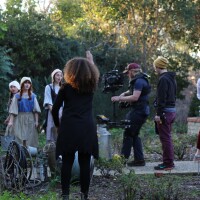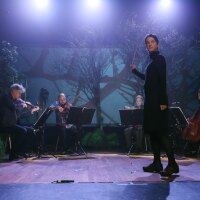Behind the Scenes of 'Vireo' Opera: A New Way to Produce an Old Art Form

Vireo, the groundbreaking made-for-TV opera, is now available for streaming. Watch the 12 full episodes and dive into the world of Vireo through librettos, essays and production notes. Find more bonus content on KCET.org and LinkTV.org.
"This is the third way that I conceptualized this," says composer Lisa Bielawa of "Vireo." The 12-episode opera web series is a groundbreaking project that merges the live sensibility of opera with modern entertainment distribution. "Vireo" began life as Bielawa's senior essay while studying literature at Yale. "I get an A on it and it gets put on a shelf. Is that it now? I was going to go into music, I wasn't going to become a literary theorist. I wasn't going to publish a book. It just didn't seem like scholarly research was the destination for this. It had too much emotional and narrative kind of juiciness to it."

After Bielawa met Erik Ehn, the librettist for "Vireo," the story began to take shape as an opera, albeit one with more traditional scenes. Twenty years later, "Vireo" came to life as an episodic opera. Bielawa notes that while there isn't any music used from the older drafts "verbatim," the influence of earlier incarnations of "Vireo" is present. "I found sketches and things that I had, musical ideas, harmonies or little fragments of melody that I had made 20 years ago," says Bielawa. "It was amazing, the process of excavating the Vireo box. I found all kinds of stuff in there."
The process of making "Vireo" took about two years and Bielawa wrote as they went along. This proved to be beneficial, as the opera's lead, Rowen Sabala, was only 16 when they began work. Bielawa notes that, while a young woman's voice can mature between the age of 16 and 18, Sabala's work on "Vireo" led to both her singing and acting techniques developing a lot during this time. "I could come back from a shoot that happened in January of 2016, for example, and hear the changes in her voice that were starting, her voice was starting to grow," says Bielawa. The composer adds that she was able to write for Sabal's maturing voice before they resumed shooting in May. "The composing of the episodes could be reactive. I could be inspired by what I heard the singers do. This was across the board, not just with the young ones that were growing, but also with the whole cast, as they deepened their own understanding of the characters."
Some of the music was written to fit the locations too. Bielawa points to the scenes featuring a hurdy-gurdy player performing in the backseat of a car as Vireo and Caroline alternate driving. "Before we signed on the dotted line for a car, we sent a hurdy-gurdy player up on one of the free days to sit in the car and see if he could play in the backseat of the car," she recalls.

When "Vireo" went on location to a farm, they needed three conductors to handle the large distances between the performers. Alcatraz presented a similar challenge. In fact, the shoot at Alcatraz turned out to be the most difficult in the process of making "Vireo."
"Alcatraz was probably the most difficult location to finally nail down and get done for a number of logistical reasons," says director Charlie Otte. "But, it was also the most magical in some ways for those very same reasons."
Since Alcatraz is a National Park, the "Vireo" team had to work around the tourists. They arrived at 5 a.m. to set everything up, left at 8 a.m. and returned at 6 p.m. for the shoot. They had to be off the island by midnight, Otte recalls, so everything happened fast. Otte points out that they had done rehearsals and had done enough work in the location scouting period to know what they wanted out of this shoot, but it was still a challenge. "It was something that we had to get right the first time and shoot it," he says. "And we did."
The process of bringing "Vireo" to life continued through editing. The opera was shot with live musicians and live singers, but it also unfolds in a way that is different from live performances. This is because Vireo exists in multiple time periods and her various incarnations overlap throughout the story. To do this, Otte filmed different takes with Vireo in different costumes. "You could do the same scene with the same staging and essentially the same camera work in a different costume, which allowed us to use jump cuts to go from time to time," he explains. "The jump cut helps us realize that we're seeing these jumps in time and space."

Daniel Leonard, who has worked on various "Artbound" shows, as well as "Artbound Presents Studio A" and "Lost L.A." for KCET was the editor for "Vireo." He worked with Otte to make those transitions between time seamless. It was a matter of finding the right musical take and the right visual take to fit the scene. It wasn't always from the time period that the team initially thought would work in a scene. "Within the editing process itself, we had a roadmap in the beginning, but we found ourselves making changes to that roadmap based on what seemed to serve the story the best in the moment when we were editing," Leonard explains.
"Working on 'Vireo' was extremely different in that it's almost like a feature film when put together," he says. "It can be seen as a feature film made up of 12 different episodes, so it's got that episodic nature, but it's also, when it's all put together, it's own feature-length piece."
Leonard notes that he worked on "Vireo" over a two-year period, editing episodes as they were made. The episodes didn't always unfold in chronological order, so he was initially editing them like television episodes. When all that was done, it was time to go back and piece everything together so that the story could be viewed either episodically or in one sitting.


